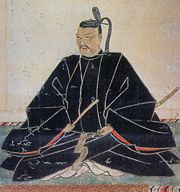
Asano Nagamasa
Encyclopedia

Toyotomi Hideyoshi
was a daimyo warrior, general and politician of the Sengoku period. He unified the political factions of Japan. He succeeded his former liege lord, Oda Nobunaga, and brought an end to the Sengoku period. The period of his rule is often called the Momoyama period, named after Hideyoshi's castle...
and one of his chief advisors. Asano also fought for Hideyoshi in a number of campaigns during the Sengoku period
Sengoku period
The or Warring States period in Japanese history was a time of social upheaval, political intrigue, and nearly constant military conflict that lasted roughly from the middle of the 15th century to the beginning of the 17th century. The name "Sengoku" was adopted by Japanese historians in reference...
of the 16th century of Japan.
Asano accompanied Hideyoshi in his campaign against the Mōri clan
Mori clan
The Mōri clan was a family of daimyō, descended from Ōe no Hiromoto and established themselves in Aki Province. Their name was derived from a shōen in Mōri, Aikō District, Sagami Province. The generation of Hiromoto began to name themselves Mōri.After the Jōkyū War, Mōri was appointed to the jitō...
, and fought in Hideyoshi's invasions of Korea. He also fought for Hideyoshi against the Hōjō clan
Late Hojo clan
The ' was one of the most powerful warrior clans in Japan in the Sengoku period and held domains primarily in the Kantō region.The clan is traditionally reckoned to be started by Ise Shinkurō, who came from a branch of the prestigious Ise clan, a family in the direct employment of the Ashikaga...
in 1590 and captured Iwatsuki and Edo castle
Edo Castle
, also known as , is a flatland castle that was built in 1457 by Ōta Dōkan. It is located in Chiyoda in Tokyo, then known as Edo, Toshima District, Musashi Province. Tokugawa Ieyasu established the Tokugawa shogunate here. It was the residence of the shogun and location of the shogunate, and also...
s.
Asano was also appointed by Hideyoshi to a Commission of Five (Go-Bugyō
Go-Bugyo
The or Five Commissioners, was an administrative organ of feudal Japan which later evolved into the Go-Tairō . It was established by Toyotomi Hideyoshi when he became kampaku in 1585....
) along with Ishida Mitsunari
Ishida Mitsunari
Ishida Mitsunari was a samurai who led the Western army in the Battle of Sekigahara following the Azuchi-Momoyama period of the 17th century. Also known by his court title, Jibunoshō...
, Maeda Gen'i, Mashita Nagamori
Mashita Nagamori
was a daimyo in Azuchi-Momoyama period, and one of the Go-Bugyō appointed by Toyotomi Hideyoshi.Also called Niemon or by his court title, Uemon-no-jō ....
and Natsuka Masaie
Natsuka Masaie
was a daimyo in the Azuchi-Momoyama period and one of the Go-Bugyō, or five commissioners, appointed by Toyotomi Hideyoshi.Born in Owari Province, Masaie served Niwa Nagahide who was a retainer of the Oda clan...
. Asano held seniority over the Commissioners, who were charged with governing the capital of Kyoto
Kyoto
is a city in the central part of the island of Honshū, Japan. It has a population close to 1.5 million. Formerly the imperial capital of Japan, it is now the capital of Kyoto Prefecture, as well as a major part of the Osaka-Kobe-Kyoto metropolitan area.-History:...
and the Home Provinces or Kinai
Kansai
The or the lies in the southern-central region of Japan's main island Honshū. The region includes the prefectures of Mie, Nara, Wakayama, Kyoto, Osaka, Hyōgo, and Shiga. Depending on who makes the distinction, Fukui, Tokushima and even Tottori Prefecture are also included...
. A close advisor to Hideyoshi, Asano devised the land survey and a number of other policies enacted under his rule.
In 1598, Hideyoshi's invasions were coming to an end, and Asano was sent to Korea with his fellow Commissioner Ishida Mitsunari to arrange for Japanese withdrawal. Asano was assured by the generals that the war was going well, and that they were on the verge of victory. Ishida disagreed, however, and supported withdrawal from Korea. Returning to Japan, daimyō (feudal lords) from across the country became involved in the debate, and the disagreement grew into a major governmental rift. The Go-Bugyō disbanded soon afterwards, having already been replaced by the Council of Five Elders
Council of Five Elders
The council of five elders, also known as the five Tairō , was formed by Toyotomi Hideyoshi to rule Japan in the place of his son, Hideyori, until such time as he came of age. Hideyoshi chose his five most powerful daimyo: Ukita Hideie, Maeda Toshiie, Uesugi Kagekatsu, Mōri Terumoto, and the...
(Tairō) by Hideyoshi before his death.
Nagamasa was succeeded by his son Asano Yoshinaga.

